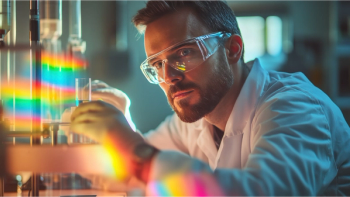
Using UV-Vis Spectroscopy To Distinguish Different Battery Types and Charge Storage Mechanisms
In situ UV-vis spectroscopy is an inexpensive and fast method that was proven to distinguish different types of batteries and energy storage mechanisms.
Researchers from the University of Manchester have introduced a new in situ UV–visible (UV-vis) spectroscopy method to distinguish battery types and the charge storage mechanism in batteries (1). To improve a battery’s energy and power density, it is important to understand energy storage mechanisms in electrochemical energy storage devices, which is where this new technique comes into play. By analyzing a novel two-dimensional (2D) titanium carbide (Ti3C2Tx MXene) in aqueous acidic and neutral electrolytes and lithium titanium oxide in an organic electrolyte, the researchers found a correlation between the evolution of UV–vis spectra and the charge storage mechanism (1).
The charge storage mechanism in batteries involves transferring electrons between two electrodes, one positive and one negative, through an electrolyte. During charging, the positive electrode accepts electrons from the negative electrode, whereas during discharging, the flow is reversed. This transfer of electrons creates an electric current that can be harnessed to power electrical devices. The efficiency of the charge storage mechanism is influenced by the properties of the electrode materials and the characteristics of the electrolyte (1).
The team calculated the electron transfer number for Ti3C2Tx in an acidic electrolyte using quantitative analysis, which was in close agreement with previous measurements using X-ray absorption spectroscopy (1). Then, the methodology was tested to distinguish the non-Faradaic process in Ti3C2Tx MXene in a water-in-salt electrolyte, despite well-defined peaks in cyclic voltammograms (1).
In situ UV-vis spectroscopy is an inexpensive and efficient technique that supplements electrochemical characterization to track changes in oxidation state and materials chemistry and determine the charge storage mechanism. This technique can help researchers better understand the energy storage mechanisms in electrochemical energy storage devices, which can ultimately lead to improved battery performance (1).
Battery technology has become increasingly important in recent years, as more and more applications require portable and rechargeable energy sources (1). From smartphones to electric vehicles, batteries play a critical role in powering modern technology (1). However, the performance and lifespan of batteries can be limited by their energy and power density, which is why understanding the energy storage mechanisms is crucial (1).
The introduction of this new in situ UV-vis spectroscopy method is a significant step forward in battery research because it provides researchers with a new tool to better understand the underlying mechanisms of battery performance (1). This development could lead to the building new materials and designing new batteries that have improved energy and power density (1).
Overall, the new in situ UV-vis spectroscopy method has the potential to make a significant impact on the field of battery research (1). By providing a fast and cost-effective way to distinguish battery types, researchers can better understand the energy storage mechanisms in electrochemical energy storage devices, ultimately leading to the development of better-performing batteries for a wide range of applications (1).
Reference
(1) Zhang, D.; Wang, R.; Wang, X.; Gogotsi, Y. In situ monitoring redox processes in energy storage using UV–Vis spectroscopy. Nat. Energy 2023.
Newsletter
Get essential updates on the latest spectroscopy technologies, regulatory standards, and best practices—subscribe today to Spectroscopy.





